[Background / related]
...
Cambodia’s Child Sex Industry Is Dwindling—And They Have Christians to Thank
From rescues to legal reform, a faithful minority changed the country’s criminal landscape.
Christianity Today | June 2017 Issue
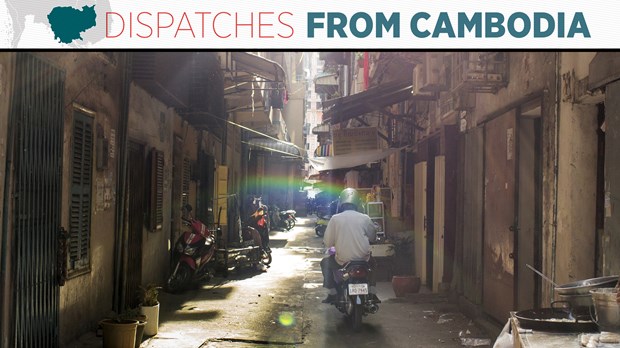 |
| Image: Esther Havens |
Sek Saroeun first read the Bible at a Phnom Penh bar where young girls were illegally sold for sex. Hamburgers were $1.00, draft beers were $1.50, and bigger bills could get you a companion for the night.
The Buddhist law student worked as a DJ at Martini Pub and had recently begun serving as an undercover informant for the Christian human rights group International Justice Mission (IJM). He scanned the room to scope out suspects as Michael Jackson boomed over the speakers. He cracked open a loaned copy of the Bible—a curiosity introduced to him through IJM—and began to make his way through it in the DJ booth.
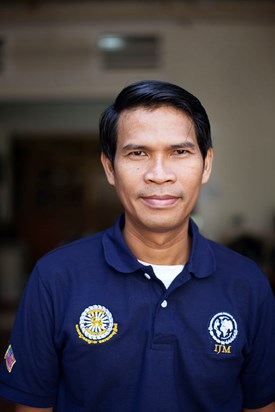
Image: Claire Eggers
Sek Saroeun, born three months after the Khmer Rouge takeover, watched Cambodia’s sex industry surge and decline. A convert to Christianity, he grew to become one of the country’s top lawyers prosecuting perpetrators of underage trafficking.
Sek took part in the organization’s earliest sex trafficking investigations in Cambodia. The Southeast Asian country had turned into a cheap, shabby hotbed for sex tourism in the decades after its notorious genocide and resulting civil unrest. In 2003, IJM launched the first large-scale attempt to fix the Khmer kingdom’s public justice system that allowed pimps and pedophiles to go free.
Excited, disgusted, and afraid of being found out during his capital city spying, Sek repeated Romans 12:12 to himself: Be joyful in hope, patient in affliction, faithful in prayer. Over time, “fear led to longing; longing led to transformation that is unimaginable,” he told colleagues at an IJM conference a decade later, explaining how he became a Christian and the group’s top lawyer in Cambodia.
“God didn’t just change me,” said Sek. “He also changed a family, a community, a nation.”
Between 2004 and 2015, Sek and his team watched the prevalence of underage girls in busy brothels, roadside massage parlors, and neon-lit karaoke bars steadily drop as they partnered with Cambodia’s anti-trafficking police and social services to rescue more than 500 victims and take about 140 child sex trafficking cases to court.
The result: In 2015, underage girls composed about 2 percent of women available for commercial sex in major cities—only a quarter of their share a few years earlier, according to IJM research. Before the project began, the Cambodian government estimated that girls under 18 accounted for as much as 30 percent of the industry.
Gray-haired foreigners on rented mopeds do still occasionally show up in Svay Pak, a dusty Phnom Penh suburb where girls younger than 10 used to offer themselves up to white men on the streets. But they can’t expect the same treatment anymore.
Along rows of tiny shops, Agape International Ministries (AIM) has taken over brothels once raided by IJM, turning them into a church, clinic, shelter, and factory in an effort to revitalize the once-sordid area. “I have seen this community transformed. They used to say this is the armpit of Cambodia,” said Phal Sokunthy, who grew up in Svay Pak and now works as an operations assistant for AIM’s 300 staff members there.
Phal, his neighbors, and most of his countrymen have had to be “patient in affliction” their whole lives. After 1975 was declared Year Zero by the communist Khmer Rouge revolutionaries who took over the government, Cambodia emptied its cities, buried 1.7 million people (20% of the population) in a genocide against the educated and religious, and forced survivors to flee to border camps as civil unrest raged on.
Thus, a traumatized generation in a pummeled economy became fertile ground for exploitation to flourish in farms, factories, and brothels. But interviews with Cambodian church leaders, social workers, government officials, and trafficking survivors paint a picture of a changing landscape in recent years, with progress largely led by Christians. They see glimpses of hope in some of the country’s darkest places.
Beyond the Rescue
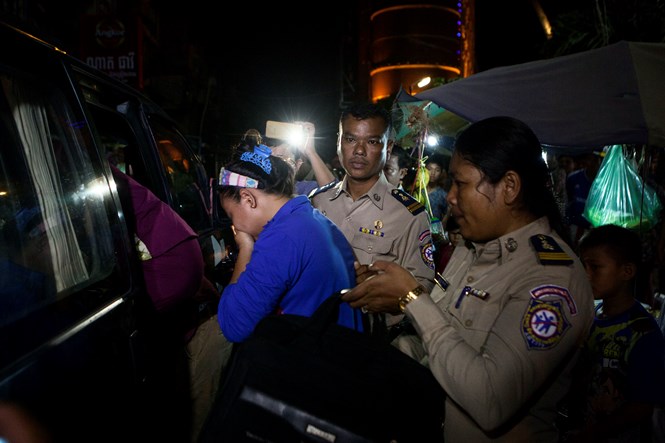
Image: Claire Eggers
Many brothels are run by older women, such as the suspects arrested in a raid by police and Agape International Ministries (AIM) last year.
The anti-trafficking police’s first raid in the notorious apartment complex results in the arrest of three women running a small, unmarked brothel. While officers gather evidence, the trio sit handcuffed on a couch in a sparse lobby leading to one room off the back and two more up a wooden ladder. Each contains a single bed, nightstand, and a ceiling so low that visitors have to crouch to step inside.
In a blur of shoulders and sequins, the six underage girls working there shuffle into a white van headed to the police station. Social workers from AIM ride alongside them and stay overnight, assuring each victim that she is not in trouble and explaining the safe house options available.
Many times, such girls will not know their exact birth date, only their sign on the Chinese zodiac; the youngest rescued that night was born in the Year of the Horse, making her 13 or 14.
Raids like this one seem to encapsulate American evangelicals’ recent fascination with the global fight against trafficking: Perpetrators arrested and jailed, and their young victims set free. But the reality in Cambodia—which ranks No. 3 in the world for modern slavery—doesn’t exactly line up with most Westerners’ faraway assumptions.
“They think all trafficking is girls chained up,” said Andy Blalock, investigations manager for AIM’s rescue team—nicknamed the “SWAT team”—which partnered with police to conduct the White Building raid as well as dozens of others last year. “It’s more the invisible chains and family pressure.”
In Cambodia, many young girls enter sex work with the consent or encouragement of their family and friends as a way to make money; along a busy street of karaoke bars and beer gardens, passersby can spot boyfriends dropping girls off at work.
When compassionate Westerners read that the commercial sex industry involves an estimated 2 million children globally, many think that in order to end sex trafficking, ministries need to free them all. But Christian leaders of the modern abolition movement in Cambodia encourage a broader understanding: Success is not about the rescue.
“Rescue is a one-off event. You can rescue 20 girls from a brothel, and they’ll get 20 more,” said Helen Sworn, founder of Chab Dai, a coalition of 50 organizations involved in trafficking prevention and recovery across Cambodia. “This is not a two- to three-year problem. It’s a lifetime problem.”
Chab Dai members—including IJM and AIM—have set their targets far beyond individual raids. To make a dent in Cambodia’s sex trafficking industry, they first had to change the nation’s institutions.
Job Done—Or Just Begun?
Compared to the emotional drama of a rescue story, training seminars, paperwork, and procedures can seem boring. But such “capacity building” (in NGO-speak) is what has worked most to get prepubescent girls out of brothels and off the streets over the past decade. Though adult prostitution is also illegal in the country, the industry thrives; activists and authorities mostly focus enforcement efforts on underage victims.
“You had a completely decimated human justice system, and no laws to enforce,” said Christa Sharpe, IJM’s vice president of global aftercare and former director of the IJM Cambodia field office. “It was clear to the international pedophile community and local communities that you could do whatever you wanted and get away with it.”
Police weren’t resourced or motivated to take on enough trafficking cases. When they did make an arrest, they fumbled through the process: taking days to issue charges and get statements, and awkwardly questioning victims alongside their traffickers.
“We had to start everything from scratch and develop the training modules . . . so the police could start to know how to identify suspects and successfully build criminal cases,” said General Sok Reaksmey, who oversees international collaboration for the National Committee for Counter-Trafficking. The former anti-trafficking officer praised Cambodia’s Christian minority and faithful Christian NGOs for being “very involved” in the cause.
As the responses of law enforcement and social services strengthened, the public slowly began trusting police more and reporting more cases. When Sharpe first worked in Cambodia more than a decade ago, “the anti-trafficking movement was led by NGOs,” she said. “Now, it’s the government.”
Confident that the legal system had improved and the youngest girls had all but disappeared from brothels (researchers found only 0.1% under the age of 15), the organization that ushered in Cambodia’s abolition movement wrapped up its work against child sex trafficking there in 2015. In its place, IJM launched a new anti-labor trafficking program in the country last year, targeting exploitation in industries that rely on deceiving, underpaying, and mistreating a desperate work force.
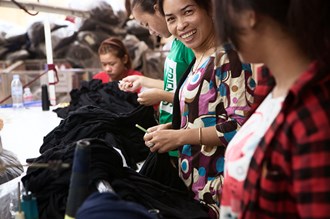
Image: Claire Eggers
AIM employs about 300 people through its ministries and factories in Svay Pak, a suburb with a heavily Vietnamese population.
Meanwhile, AIM continues its community-building work in Svay Pak, a 10,000-person village with a concentrated Vietnamese population. Many of the ministry’s neighbors have connections to the Vietnamese crime syndicates involved in child sex trafficking in Cambodia. (One Chab Dai study found that Vietnamese make up only 5% of Cambodia’s population, yet 60–70% of girls in its aftercare shelters.)
AIM attempts to address the underlying reasons girls get sold in the first place. For any “excuse” families have for prostituting their daughters, it tries to offer an immediate solution. Can’t afford education? Join their kids’ club, community school, or adult English classes. A medical emergency that requires immediate funds? Come to their free clinic. No job? AIM will offer one on the spot. Their clothing factory—where 200 workers stitch cardigans and T-shirts to be sold at Macy’s—pays two to five times the average wage, plus it offers free childcare.
Meanwhile, a storefront kickboxing gym invites pimps, brokers, and abusers to train, supplementing workouts with discussions on godly manhood. When community members end up arrested for trafficking or other criminal activity, AIM offers to house and support their families at a short-term shelter.
“We believe God wants to transform every life: the victim, and the victimizer as well,” said AIM’s country director Clayton Butler, who greets everyone on the street right down to the drug dealers. (In the national language, Khmer, he asks: “What are you selling? Meth?”) “The longer I work here, I don’t have more hate and more anger. I have more compassion.”
Don Brewster, the American pastor who founded AIM and moved to Svay Pak in 2005, says the police crackdown has led traffickers to try to outsmart the system. Trafficking is a big business in a country where most live on a few bucks a day. Brothel ledgers show girls with 10 or 20 clients a night, which results in enough income for even small operations to bring in over a million dollars a year.
“Whenever the anti-trafficking movement has success, trafficking evolves and moves as a result,” Brewster said. He thinks the IJM research hasn’t adequately captured the underground industry.
Through a network of Cambodian informants and undercover investigators, AIM has recovered more than 100 underage girls in the past few years alone. The team has noticed how traffickers move to unexpected establishments (say, a high-end barber shop or supermarket); rotate girls between multiple locations; hire lookouts; or wait several months, until a client is trusted, before offering younger girls or even pricier virgins. These strategies make it harder for investigators to build a case and for police to authorize a raid.
Turning off the touristy street along Phnom Penh’s murky Tonle Sap River, the director of the AIM rescue team, Eric Meldrum, can barely make it a few blocks before pointing out places they have raided and spots they are currently investigating: That nice restaurant. In the back of that salon. That beer garden. More than half of sex trafficking raids in Cambodia in 2015 came through his office.
Clusters of women in tank tops and short skirts sit on plastic chairs outside massage parlors, scrolling through their phones or chatting with each other while waiting for customers. At “hostess” bars, men can pay to take women off-site for sex. An estimated 70 percent of Cambodian men have paid for sex, and tourist websites advise foreigners where to go and how to negotiate, transliterating the Khmer phrases to request various sex acts.
“There are no longer prepubescent girls [on the streets] . . . and it’s not a haven for pedophiles. And that’s a big step forward,” said Meldrum, a former police detective in the UK. “But that doesn’t mean there are no girls.”
Understanding Trauma over Time
There’s still a lot that even experts don’t know about the trauma that women—and men—coming out of trafficking carry with them. When Sworn heard of a woman who committed suicide years after leaving a shelter and “successfully” transitioning (getting a new job and getting married), the Chab Dai leader launched the world’s first-ever longitudinal study on trafficking survivors. Currently in its eighth year, the Butterfly Project tracks a cohort of more than 120 survivors and the financial anxieties, emotional struggles, and stigmas they face.
“We had a responsibility to find out what was happening to these women when they got back to their communities,” said Sworn, who keeps a library of 3,000 pieces of trafficking research in English and Khmer. “The rescue is one action that leads to a lifetime of hard work.”
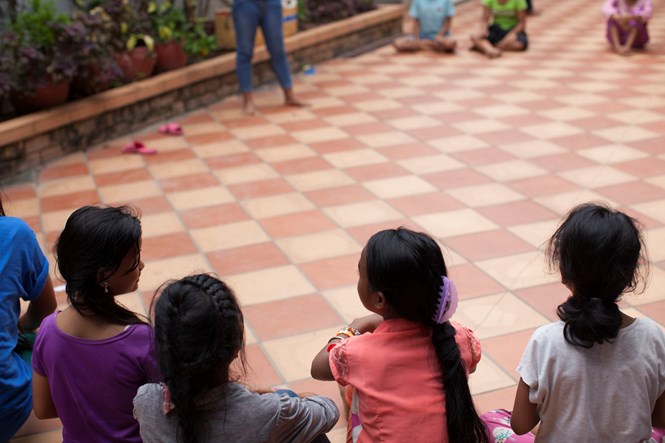
Image: Claire Eggers
About 25 tweens and teens live at the Pleroma Home for Girls in Phnom Penh. “I have sisters here; they are my family,” a 15-year-old said through a translator. “God helped me when I had no hope. He has shown me who I am. I’m a daughter, who is special and important to him.”
At the Pleroma Home for Girls in a popular suburban neighborhood, the sounds of bare feet smacking on the pavement and shrieking laughter echo in the gated courtyard as two dozen girls, most in their tweens and early teens, play before dinner. “I notice here that I am valued, worthy, special, and significant,” said an 18-year-old. She worried about leaving her friends and returning home in the coming weeks. “A lot of people are encouraging me to face my problems and think about my future.”
All the girls at Pleroma are survivors of sex trafficking or rape, but that’s rarely all. Most had been forced to quit school to work, and suffered abuse or neglect from overwhelmed parents.
“It is difficult for the girls with multiple traumatic events in their life. They do not trust easily, and every time, their emotions come out,” said Ngeth Kimsang, one of Pleroma’s social workers. “I ask them, ‘What would you ask God?’ Because only God can always be trusted.”
Christian shelters introduce the gospel in their programs. And while they don’t require girls to attend church or convert, many find God anyway.
The Buddhist notion of karma weighs heavy on victims. “They’ve been told it’s because of what they did in the past, or that they’re not lucky,” said Hannah Burkle, country director for Rapha House, which operates shelters in the major Cambodian cities of Siem Reap and Battambang. It’s especially bad karma not to repay debts, so girls often work because they feel financially obligated to their trafficker or their parents.
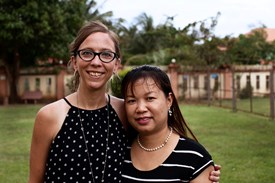
Image: Claire Eggers
Rapha House’s operations are led by Cambodia director Hannah Burkle and education director Sour Channy. The girls in their care attend school, language classes, and job training in fields like sewing, hairstyling, and cooking.
Compared to that burden, the Father’s love comes as life-changing good news. Many survivors said the love of God was the greatest thing they learned in recovery. However, nearly all of them will return to villages where their new faith will put them in the minority. “We teach them about how Jesus was rejected and Mary was rejected,” Burkle said. “Not just about God’s love.”
Rapha House has more than 70 girls at its shelter in Battambang, Cambodia’s third-largest city. The program offers specialized care, from a colorful boat behind the house outfitted as an art therapy space to a facility where girls with special needs (from autism to cerebral palsy) can receive physical therapy and their own lessons in gardening, baking, and other life skills.
Back in Phnom Penh, staff at the AIM Restoration Home—where the victims rescued from the White Building were sent—are learning sign language to communicate with a deaf resident. The home also welcomes trafficking victims with children of their own, caring for the babies and toddlers while their teenage moms attend school.
Facing the Future with Faith
Cambodia has made significant progress in reducing child sex trafficking over the past decade, but as trafficking evolves—going deeper underground, crossing borders, and catering to online pedophiles—it poses new challenges.
“Once we solve one problem, the perpetrator will [create] two or three more problems,” said Her Excellency Chou Bun Eng, vice-chair of the government’s National Committee for Counter-Trafficking.
Exploitation proves to be an ongoing fight and another enduring test of patience for Cambodians. But she trusts Christians will continue to stay involved.
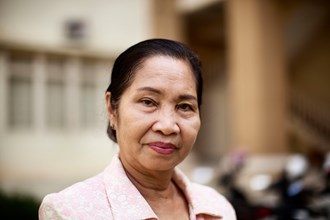
Image: Claire Eggers
Her Excellency Chou Bun Eng, vice-chair of the National Committee for Counter-Trafficking, is one of the highest ranking women in the Cambodian government and celebrates the progress in the country’s fight against trafficking. “We still have some problems, but the improvements have been achieved already,” she told CT. “We can’t say it’s good or excellent, but it’s better than before.”
“We found they are very committed to assisting vulnerable people,” the Buddhist official said in her government office. “They work by faith.”
Several government and police officials—non-Christians themselves—have credited Christian organizations with prompting their recent anti-trafficking progress.
While government and NGO leaders think ahead to the next front for trafficking, Chandra Chap keeps her focus set on what’s next for the 24 girls under her care. Last fall, the Cambodian American operator of Pleroma prepared to send four girls home to their families, some after living at the shelter for four years.
“The conviction of the Lord is very strong, and the stories of the girls keep me going,” said Chap, a social worker who has worked with young survivors since 2011. “I want them to be leaders in their community. I use the title ‘Excellency,’ as in, ‘You are an excellent person and you will teach others.’ I want them to be lawyers and doctors. They are our future.”
Kate Shellnutt is online associate editor for CT.



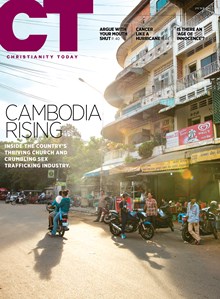
No comments:
Post a Comment